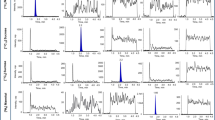Abstract.
The biophysical nature of blood-brain barrier (BBB) opening after ischemic or hemorrhagic stroke or traumatic brain injury is unresolved. Ultrastructural (electron micrograph) investigations of experimental BBB injury commonly indicate the abnormal presence of vesicles or tubular structures in cerebrovascular endothelial cells, suggesting the likelihood of convective, fluid-phase transport of blood substances into brain. We measured transfer constants (Kis) for the simultaneous passage of two intravenously delivered tracers ([14C]sucrose, mol wt=342; [3H]inulin ≈5,000) across the intact BBB in the rat, and 24 h after global cerebral ischemia (16–20 min duration) or 24, 48 or 72 h after focal ischemia (2 h duration). In both ischemia models, the upward increment in Ki (ΔKi) for sucrose, indicating the extra injury-related tracer flux into brain, significantly exceeded that for inulin, as might be expected with faster diffusion of the smaller molecule through injury pores or channels. This inequality of ΔKis did not suggest a major role for convective, fluid-phase transport by endothelial vesicular or tubular structures and a predominance of diffusional transport was indicated.
Similar content being viewed by others
Author information
Authors and Affiliations
Additional information
Revised, accepted: 3 August 2001
Electronic Publication
Rights and permissions
About this article
Cite this article
Preston, E., Webster, J. Differential passage of [14C]sucrose and [3H]inulin across rat blood-brain barrier after cerebral ischemia. Acta Neuropathol 103, 237–242 (2002). https://doi.org/10.1007/s004010100458
Received:
Published:
Issue Date:
DOI: https://doi.org/10.1007/s004010100458




